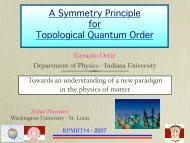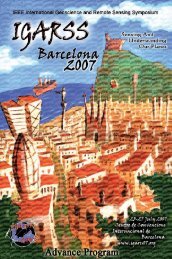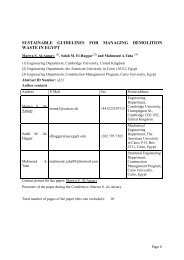innovative fe-analysis of the roller burnishing process for different ...
innovative fe-analysis of the roller burnishing process for different ...
innovative fe-analysis of the roller burnishing process for different ...
Create successful ePaper yourself
Turn your PDF publications into a flip-book with our unique Google optimized e-Paper software.
X International Con<strong>fe</strong>rence on Computational Plasticity<br />
COMPLAS X<br />
E. Oñate and D. R. J. Owen (Eds)<br />
© CIMNE, Barcelona, 2009<br />
INNOVATIVE FE-ANALYSIS OF THE ROLLER BURNISHING<br />
PROCESS FOR DIFFERENT GEOMETRIES<br />
F. Klocke * , V. Bäcker * , H. Wegner * , A. Timmer *<br />
* Chair <strong>of</strong> Manufacturing Technologies, Laboratory <strong>for</strong> Machine Tools and Production Engineering<br />
RWTH Aachen University<br />
Steinbachstr. 19, 52074 Aachen, Germany<br />
e-mail: V.Baecker@wzl.rwth-aachen.de, web page: http://www.wzl.rwth-aachen.de<br />
Key words: Incremental Forming Process, Finite Element Analysis, Fan Blades.<br />
Summary This article shows <strong>the</strong> model development using <strong>the</strong> FEA <strong>for</strong> <strong>roller</strong> <strong>burnishing</strong><br />
applied on dif<strong>fe</strong>rent geometries. The aim <strong>of</strong> this work is <strong>the</strong> development <strong>of</strong> valid and<br />
ef<strong>fe</strong>ctive FE-models, which are able to provide a quantitative prediction <strong>of</strong> <strong>the</strong> rime zone state<br />
<strong>of</strong> <strong>roller</strong> burnished workpieces. These FE-models are verifiable through <strong>the</strong> comparison <strong>of</strong> <strong>the</strong><br />
calculated residual stress state with <strong>the</strong> experimental results <strong>of</strong> <strong>roller</strong> <strong>burnishing</strong> tests.<br />
1 INTRODUCTION<br />
The small damages by unavoidable impacts <strong>of</strong> <strong>for</strong>eign objects on heavily loaded turbojet<br />
engine components, like fan and compressor blades, can result in oscillating fatigue and<br />
breakage during continued operation. This type <strong>of</strong> damage represents more than 25% <strong>of</strong> <strong>the</strong><br />
most frequent causes <strong>for</strong> cost-extensive engine overhauling [7].<br />
Previous research results [2], [5], [6] show that applying a mechanical strain to harden <strong>the</strong><br />
rime zone leads to a significant increase <strong>of</strong> <strong>the</strong> damage tolerance. Such a treatment can be<br />
achieved with <strong>the</strong> manufacturing <strong>process</strong> <strong>of</strong> <strong>roller</strong> <strong>burnishing</strong>. This <strong>process</strong> distinguishes itself<br />
by substantial advantages from o<strong>the</strong>r mechanical strain hardening methods: high and deeply<br />
reaching compressive residual stresses, high strain hardening and excellent surface quality [6].<br />
However, <strong>the</strong> determination <strong>of</strong> optimal <strong>process</strong> parameters <strong>for</strong> a given load still requires an<br />
elaborate experimental set-up and subsequent time-consuming and cost-extensive<br />
measurements <strong>of</strong> <strong>the</strong> rime zone’s state. Previous publications [1], [3], [4] proposed <strong>the</strong><br />
application <strong>of</strong> <strong>the</strong> Finite Element Analysis (FEA) as an ef<strong>fe</strong>ctive and cost reducing alternative<br />
to an experimental set-up. However, <strong>the</strong>se works were only able to provide a qualitative<br />
prediction <strong>of</strong> <strong>the</strong> rime zone state due to <strong>the</strong> simplifications <strong>the</strong>y imposed to <strong>the</strong> model<br />
geometry, boundary conditions and material.<br />
This article shows <strong>the</strong> model development using <strong>the</strong> FEA <strong>for</strong> dif<strong>fe</strong>rent geometries <strong>of</strong> an<br />
analogue test specimen (Figure 1). These geometries were chosen specifically to represent<br />
typical shapes <strong>of</strong> turbine blade and turbine disk components. Two common materials <strong>of</strong> <strong>the</strong><br />
aerospace industry were used (Ti-6Al-4V and IN718). The developed FE-models are<br />
verifiable through <strong>the</strong> comparison <strong>of</strong> <strong>the</strong> calculated residual stress state with <strong>the</strong> experimental<br />
results <strong>of</strong> <strong>the</strong> <strong>roller</strong> <strong>burnishing</strong> tests.
F. Klocke, V. Bäcker, H. Wegner and A. Timmer.<br />
2 MODEL DEVELOPMENT<br />
In <strong>the</strong> following sections <strong>the</strong> developed FE-models will be described (Figure 1).<br />
Figure 1: Modelling <strong>of</strong> <strong>the</strong> <strong>roller</strong> <strong>burnishing</strong> <strong>process</strong> <strong>for</strong> dif<strong>fe</strong>rent geometries<br />
The determination <strong>of</strong> an accurate stress distribution in <strong>the</strong> rime zone requires a high<br />
number <strong>of</strong> elements, which makes a simulation <strong>of</strong> <strong>the</strong> complete geometry impossible.<br />
There<strong>for</strong>e cut-out dimensions <strong>for</strong> each geometry were defined. This allows a robust and timeefficient<br />
<strong>roller</strong> <strong>burnishing</strong> simulation. In order to ensure a minimal influence <strong>of</strong> <strong>the</strong> boundaries<br />
on <strong>the</strong> stress development, symmetric boundary conditions were applied on <strong>the</strong>se surfaces.<br />
Each section was modelled as a de<strong>for</strong>mable 3D-body. The <strong>roller</strong> <strong>burnishing</strong> tools were<br />
simplified and modelled as rigid balls. This assumption is valid, because <strong>of</strong> <strong>the</strong> high hardness<br />
<strong>of</strong> <strong>the</strong> tungsten carbide <strong>roller</strong> ball (~2400 HV) compared to <strong>the</strong> <strong>process</strong>ed material (~450 HV).<br />
Contact between tool and workpiece was modelled using a finite-sliding <strong>for</strong>mulation where<br />
separation and sliding <strong>of</strong> finite amplitude, and arbitrary rotation <strong>of</strong> <strong>the</strong> surfaces may arise. The<br />
normal contact behaviour between <strong>the</strong> contact surfaces was modelled using <strong>the</strong> hard contact<br />
<strong>for</strong>mulation implemented in ABAQUS. The contact constraint is en<strong>for</strong>ced with a Lagrange<br />
multiplier representing <strong>the</strong> contact pressure in a mixed <strong>for</strong>mulation. The friction was modelled<br />
using an extended version <strong>of</strong> <strong>the</strong> classical isotropic Coulomb friction model. The extensions<br />
include an additional limit on <strong>the</strong> allowable shear stress, anisotropy, and <strong>the</strong> definition <strong>of</strong> a<br />
“secant” friction coefficient. Thereby, <strong>the</strong> friction model is able to consider stick-slip-ef<strong>fe</strong>cts,<br />
which can occur during <strong>roller</strong> <strong>burnishing</strong> at high pressures.<br />
The behaviour <strong>of</strong> <strong>the</strong> used materials, IN718 and Ti-6Al-4V, was modelled using <strong>the</strong><br />
implemented ABAQUS material models <strong>for</strong> metals subjected to cyclic loading. The elastic<br />
material behaviour was described using a linear elasticity model, whereas <strong>for</strong> <strong>the</strong> plastic<br />
behaviour a nonlinear, isotropic/kinematic hardening model was used. The model parameters<br />
<strong>for</strong> <strong>the</strong> description <strong>of</strong> <strong>the</strong> elastic material behaviour and <strong>for</strong> <strong>the</strong> plastic hardening were<br />
determined from material examinations and cyclic tests.<br />
2
F. Klocke, V. Bäcker, H. Wegner and A. Timmer.<br />
3 MODEL VALIDATION<br />
To achieve quantitative comparison with experimental results, highly accurate simulation<br />
results are required. In order to obtain statistically firm simulation results, an evaluation <strong>of</strong> a<br />
single validation line is insufficient. The heterogeneity <strong>of</strong> <strong>the</strong> numerical results makes an<br />
evaluation <strong>of</strong> a previously defined validation volume necessary.<br />
Figure 2: Concept <strong>of</strong> <strong>the</strong> evaluation methodology <strong>for</strong> plane and curved geometries<br />
The concept <strong>of</strong> <strong>the</strong> evaluation methodology is shown in Figure 2. The predefined<br />
validation volume consists <strong>of</strong> a number <strong>of</strong> surfaces, which are determined by <strong>the</strong> mesh<br />
density. Each validation surface consists <strong>of</strong> a number <strong>of</strong> validation lines, which lie within this<br />
surface. By averaging <strong>the</strong>se results <strong>for</strong> each surface a representative distribution over <strong>the</strong><br />
depth can be obtained.<br />
Figure 3: Contour plots and residual stress distributions <strong>for</strong> <strong>roller</strong> <strong>burnishing</strong><br />
3
F. Klocke, V. Bäcker, H. Wegner and A. Timmer.<br />
In order to provide a quantitative comparison <strong>of</strong> <strong>the</strong> simulated and experimental results,<br />
this evaluation methodology was applied. The results <strong>of</strong> this comparison are shown<br />
exemplarily <strong>for</strong> <strong>the</strong> <strong>roller</strong> <strong>burnishing</strong> <strong>of</strong> Ti-6Al-4V (Figure 3). They achieve generally a very<br />
good correlation between calculated and measured results <strong>for</strong> all geometries.<br />
The distribution <strong>of</strong> <strong>the</strong> residual stresses <strong>for</strong> thin walled geometries dif<strong>fe</strong>rs significantly<br />
from <strong>the</strong> stress distribution observed and calculated <strong>for</strong> plane geometry, which is af<strong>fe</strong>cted<br />
only in <strong>the</strong> rime zone <strong>of</strong> <strong>the</strong> <strong>process</strong>ed surface. Thin walled geometries are influenced over<br />
<strong>the</strong>ir complete thickness. Due to <strong>the</strong> <strong>roller</strong> <strong>burnishing</strong> <strong>process</strong>, negative residual stresses are<br />
induced in <strong>the</strong> rime zone. These stresses are compensated by positive residual stresses in <strong>the</strong><br />
inner part <strong>of</strong> <strong>the</strong> workpiece.<br />
The contour plot <strong>of</strong> <strong>the</strong> residual stress in <strong>the</strong> simulation using curved geometry shows that<br />
<strong>the</strong> <strong>roller</strong> <strong>burnishing</strong> <strong>process</strong> does not induce stresses only in <strong>the</strong> <strong>process</strong>ed curved zone. The<br />
stress induction is extended to <strong>the</strong> adjacent plane areas.<br />
4 CONCLUSIONS<br />
The high stress gradients in <strong>the</strong> rime zone after <strong>roller</strong> <strong>burnishing</strong> require fine meshing <strong>of</strong><br />
this area, which limits <strong>the</strong> model size and renders a macro-modelling <strong>of</strong> <strong>the</strong> <strong>roller</strong> <strong>burnishing</strong><br />
<strong>process</strong> as time-inefficient or even impossible. The model simplifications and <strong>the</strong> assumptions<br />
made in <strong>the</strong> modelling phase cause additional scatter to <strong>the</strong> numerical errors and have to be<br />
chosen carefully. A quantitative prediction <strong>of</strong> <strong>the</strong> residual stress state <strong>of</strong> <strong>the</strong> rime zone<br />
requires a sophisticated and representative validation strategy based on statistically firm<br />
evaluation <strong>of</strong> <strong>the</strong> model results, which is what <strong>the</strong>se FE-models achieve. All developed FEmodels<br />
were validated and are able to predict <strong>the</strong> residual stress state after <strong>roller</strong> <strong>burnishing</strong><br />
with sufficient accuracy.<br />
5 AKNOWLEDGEMENT<br />
The authors gratefully acknowledge <strong>the</strong> financial support from <strong>the</strong> European 6th<br />
Framework Programme through <strong>the</strong> research project VERDI (Virtual Engineering <strong>for</strong> Robust<br />
Manufacturing with Design Integration; http://www.verdi-fp6.org).<br />
REFERENCES<br />
[1] C. Achmus, Messung und Berechnung des Randschichtzustands komplexer Bauteile nach dem Festwalzen,<br />
PhD-Thesis, TU-Braunschweig, 1999<br />
[2] G. Berstein, G. Fuchsbauer, Festwalzen und Schwing<strong>fe</strong>stigkeit, Werkst<strong>of</strong>ftechnik, Vol. 13, 1982<br />
[3] U. Jung, FEM-Simulation und experimentelle Optimierung des Festwalzens bauteilähnlicher Proben<br />
unterschiedlicher Größen, PhD-Thesis, TU Darmstadt, 1996<br />
[4] S. Mader, Festwalzen von Fan- und Verdichterschau<strong>fe</strong>ln, PhD-Thesis, RWTH Aachen, 2007<br />
[5] T. Oppermann, Beitrag über die Schwing<strong>fe</strong>stigkeitssteigerung in Wöhler- und Betriebs<strong>fe</strong>stigkeitsversuchen<br />
durch Reinigungsstrahlen und Festwalzen konventionell und vereinfacht wärmebehandelter<br />
bauteilähnlicher Stahlproben, PhD-Thesis, TU Darmstadt, 1993<br />
[6] P.S. Prevéy, M.J. Shepard and P.R. Smith, The ef<strong>fe</strong>ct <strong>of</strong> low plasticity <strong>burnishing</strong> (LPB) on <strong>the</strong> HCF<br />
per<strong>for</strong>mance and FOD resistance <strong>of</strong> Ti-6Al-4V, Proceedings <strong>of</strong> <strong>the</strong> 6th national turbine engine high cycle<br />
fatigue con<strong>fe</strong>rence, Jacksonville, Florida, 2001<br />
[7] A. Rossmann, Die Sicherheit von Turbo-Flugtriebwerken, Vol. 1, Turbo Consult, Karls<strong>fe</strong>ld, 2000<br />
4





